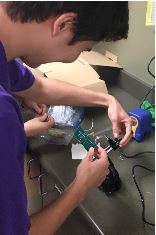
 By Jonathan Stroud
By Jonathan Stroud
JournalistsForSpace.com
Journalists For Space sat down with the San Diego Youth Space Program (SDYSP) to get a first-hand look at the club’s latest experiment launching to the International Space Station (ISS) this spring.
Founded in 2011, the SDYSP gives high school students the opportunity to design, build, and test palm-sized experiments in microgravity. Only a few schools in the world have the privilege to participate in the student-led ISS project. The students’ 2017 project is slated to launch on a SpaceX Falcon 9 rocket in early April.
Maranatha Christian High School, who has partnered with six other high schools from the San Diego area, provides students with hands-on experience that is unmatched in a traditional classroom environment. The experiments are made possible by the sponsorship and partnership of Realcomm, Quest Institute, NASA, and Nanoracks. Together, students learn teamwork, engineering, public relations, and other valuable skills that are required for successfully conducting experiments in low Earth orbit.
Split up into teams to model a real-world company project, each student has a specific task that plays a vital role in the success of the mission. Mentors assist and guide the students with the experiments, but the full responsibility falls on the students to complete the projects.
This years’ SDYSP palm-sized device is designed to measure how plant growth is affected by light in microgravity, known as phototropism. The experiment aims to better understand how humans can use plants as a source of food and oxygen during future space travel.

Student Project Manager Jessica Xu shared the team’s thoughts on the possible outcomes of the phototropism experiment: “We hope to see if it [the plant] will grow towards the light and if it doesn’t grow towards the light, like it does here on Earth, then we will learn something interesting about the way plants grow in microgravity.”
Xu continued, “I have learned a lot of hands-on engineering skills with these projects, especially electrical engineering. The most rewarding part is just getting exposed to a real world project because I don’t really get that in the high school classroom setting.”
This will be the second attempt by the team to send a phototropism experiment to the ISS. Unfortunately, the previous year’s project was met with failure due to a miscoding in the experiments’ software.
According to club mentor Bill Miller, the failure served as an important lesson to students that space is not easy. He told Journalists For Space, “Persistence. We had an experiment that wasn’t exactly right, but we followed up with another year where we have tried to make it right.”
“It’s a lot of fun spending Tuesdays with a bunch of space nerds.”
– Janelle Hicks
Additionally, there are two more experiments currently being developed by the students to compete for space on a future flight to the ISS, as early as 2018. The secondary experiments will focus on the effects of decomposition in microgravity and the study of separating mixtures, known as chromatography.
The decomposition experiment will measure the effects of food deterioration in microgravity. Decomposition team member Ilana Stone explained, “The problem with our experiment is that it has to stay in a warehouse before it is launched which can be for several months. If you have organic matter, you don’t want it to decompose before you send it to space; otherwise, you don’t know what happened in space and what happened on Earth.”
To prevent the issue of pre-decomposition prior to launch, the team plans to use rice which will be exposed to water once it reaches the ISS. The students will then use a small camera inside the experiment to study the development and formation of mold in hopes of better understanding how it grows in microgravity.
The chromatography experiment, if selected, will use amino acids in an attempt to model how molecules travel in a biological system in space. Chromatography team member Rowan Ranjbar explained the experiment as, “a more complicated version of what we did in chemistry class. In class, we drew a line of ink on paper and saw how long it took to separate the pigments in the ink…It’s relevant because when you put an amino acid on a piece of chromatography paper, it travels up the paper at a different rate depending on what molecular groups are attached to it.”

The unique experience of working on a project with real-world implications is leaving a positive lasting impact on the SDYSP students.
Phototropism software team member Janelle Hicks described her experience with the SDYSP as one of her biggest accomplishments as a student. She said, “I think the most I’m taking out of this is knowing that I’m contributing to one of the biggest things I’ve ever done…Meeting new people and working with people I have never met before has been a really special experience. Plus, it’s a lot of fun spending Tuesdays with a bunch of space nerds.”

For more information on current, future and past projects check out the SDYSP website by Clicking Here.
Keep up with the latest space news and content at Journalists For Space.


Leave a comment